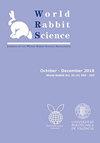埃及兔品种的分子遗传多样性和保护重点
IF 1.3
4区 农林科学
Q3 AGRICULTURE, DAIRY & ANIMAL SCIENCE
引用次数: 5
摘要
埃及有限的兔子资源正面临灭绝的危险,而对本地品种的遗传多样性研究可能在保护和改进这些品种方面发挥至关重要的作用。在本研究中,使用12个微卫星标记对3个本地兔品种:Gabali(G)、Baladi Red(BR)和Baladi Black(BB)以及新西兰White(NZW)进行了基因分型。所有分型的微卫星均具有多态性,平均每个位点有5.25个等位基因。每个基因座的观察杂合度和预期杂合度分别为0.62和0.68。平均多态信息含量为0.71,多态信息含量最高的位点为SOL33,为0.85。除SAT7和SAT2外,所有研究位点均偏离Hardy-Weinberg平衡,且水平显著。个体间的近交系数为0.07。群体内杂合子缺失平均为0.07,在BR品种中为0.141,在BB品种中为0.015。群体间的成对分化最高的是BB和NZW(0.071),而最低的是BR和G(0.038)和BB(0.039),而NZW和BB品种间最高(0.409)。BR和G种群聚在一起形成混合镶嵌群。根据所使用的三种优先排序方法,BR在总遗传多样性中的贡献最高。本文章由计算机程序翻译,如有差异,请以英文原文为准。
Molecular genetic diversity and conservation priorities of Egyptian rabbit breeds
The limited rabbit resources in Egypt are threatened by the danger of extinction, whereas genetic diversity studies of native breeds could play a vital role in conservation and improvement of these breeds. In this study, 3 native rabbit breeds: Gabali (G), Baladi Red (BR) and Baladi Black (BB), in addition to New Zealand White (NZW), were genotyped using 12 microsatellite markers. All the typed microsatellites were polymorphic by average number of alleles 5.25 per locus. Observed and expected heterozygosity per locus averaged 0.62 and 0.68, respectively. The average polymorphic information content was 0.71 and the highest polymorphic information content was recorded in locus SOL33 by 0.85. All the studied loci except SAT7 and SAT2 showed deviation from Hardy-Weinberg equilibrium with significant level. The inbreeding coefficient of the individuals relative to the total population was 0.07. The within-population heterozygote deficit averaged 0.07 and ranged from 0.141 in BR to 0.015 in BB breeds. The highest pairwise differentiation among the populations was recorded between BB and NZW (0.071), while the lowest value was recorded between BR and both of G (0.038) and BB (0.039). The lowest pairwise Nei’s genetic distance was recorded between BR and BB (0.190), while the highest was recorded between NZW and BB breeds (0.409). BR and G populations were clustered together forming an admixed mosaic cluster. BR recorded the highest contribution in the aggregate genetic diversity based on the three prioritisation methods used.
求助全文
通过发布文献求助,成功后即可免费获取论文全文。
去求助
来源期刊

World Rabbit Science
农林科学-奶制品与动物科学
CiteScore
1.70
自引率
25.00%
发文量
22
审稿时长
>36 weeks
期刊介绍:
World Rabbit Science is the official journal of the World Rabbit Science Association (WRSA). One of the main objectives of the WRSA is to encourage communication and collaboration among individuals and organisations associated with rabbit production and rabbit science in general. Subject areas include breeding, genetics, production, management, environment, health, nutrition, physiology, reproduction, behaviour, welfare, immunology, molecular biology, metabolism, processing and products.
World Rabbit Science is the only international peer-reviewed journal included in the ISI Thomson list dedicated to publish original research in the field of rabbit science. Papers or reviews of the literature submitted to World Rabbit Science must not have been published previously in an international refereed scientific journal. Previous presentations at a scientific meeting, field day reports or similar documents can be published in World Rabbit Science, but they will be also subjected to the peer-review process.
World Rabbit Science will publish papers of international relevance including original research articles, descriptions of novel techniques, contemporaryreviews and meta-analyses. Short communications will only accepted in special cases where, in the Editor''s judgement, the contents are exceptionally exciting, novel or timely. Proceedings of rabbit scientific meetings and conference reports will be considered for special issues.
World Rabbit Science is published in English four times a year in a single volume. Authors may publish in World Rabbit Science regardless of the membership in the World Rabbit Science Association, even if joining the WRSA is encouraged. Views expressed in papers published in World Rabbit Science represent the opinion of the author(s) and do not necessarily reflect the official policy of the WRSA or the Editor-in-Chief.
 求助内容:
求助内容: 应助结果提醒方式:
应助结果提醒方式:


